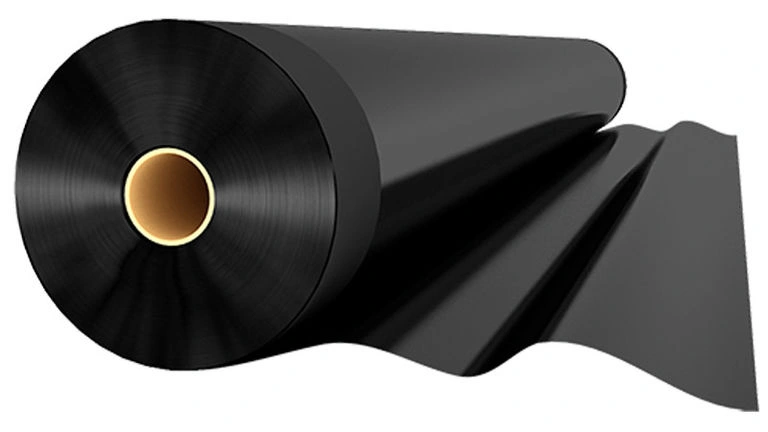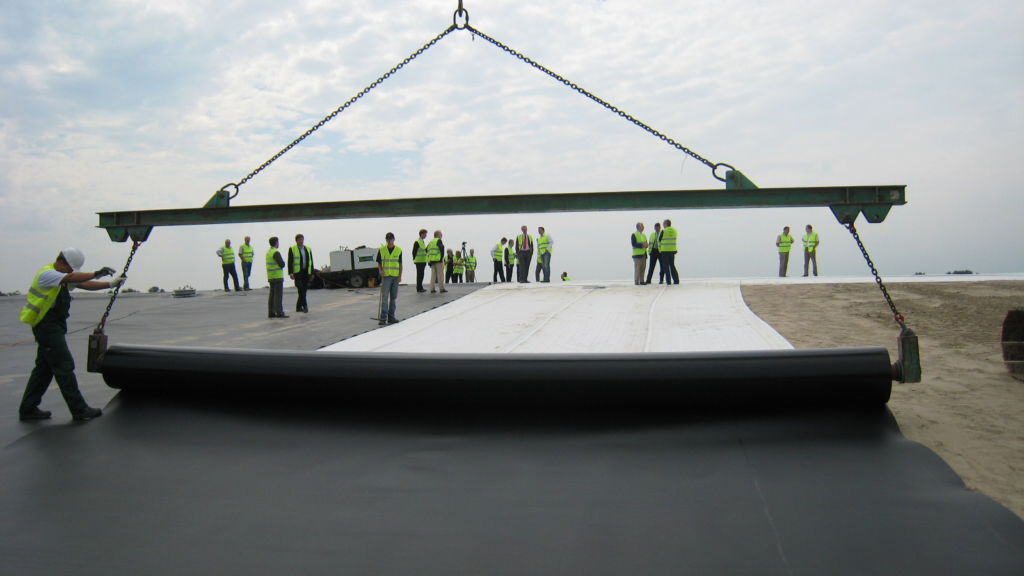Life of HDPE geomembrane
High-density polyethylene geomembrane (HDPE geomembrane) is widely used in environmental protection, civil engineering, water conservancy engineering and other fields. Due to its excellent physical and chemical properties, HDPE geomembrane has significant advantages in many long-term anti-seepage projects. The service life of HDPE geomembrane will be affected by many factors, including raw material characteristics, construction quality, environmental conditions, etc. Understanding these influencing factors will help to reasonably evaluate its life and take effective measures to extend its service life.

Characteristics of HDPE geomembrane
HDPE geomembrane uses high-density polyethylene (HDPE) as raw material and has the following advantages:
- Impermeability: HDPE membrane has excellent waterproof and impermeability, which can effectively prevent liquid penetration. It is the preferred material for landfills, sewage treatment plants, mine tailings ponds and other places that require strict anti-seepage.
- Chemical corrosion resistance: HDPE membrane has strong corrosion resistance to most chemicals, especially in acid, alkali and saline soils.
- UV resistance: HDPE membrane has outstanding performance in UV resistance, can withstand long-term UV exposure, and is not easy to age due to UV exposure.
- Mechanical strength: HDPE membrane has high tensile strength and wear resistance, and is suitable for use in environments with large loads.
- Environmental protection: HDPE membrane is a recyclable environmentally friendly material and is harmless to the environment during use.
Life Assessment of HDPE Geomembrane
The life of HDPE geomembrane usually refers to the time it can maintain its basic performance without significant degradation or failure under specific conditions. According to a large number of engineering practices and research, the service life of HDPE geomembrane can usually reach 30 to 50 years, or even longer, and the specific life depends on the following key factors.
- Raw material quality; The life of HDPE geomembrane is first affected by the quality of raw materials. High-quality polyethylene resin, production process and additives can enhance the film’s UV resistance, chemical corrosion resistance, oxidation resistance and other properties, thereby improving its durability. Membranes made of standard HDPE materials and processed through scientific and reasonable production processes usually have a longer life.
- Construction quality; The construction process has a significant impact on the service life of HDPE geomembrane. If the membrane is damaged during construction (such as cutting, puncturing, etc.), or the joints are not tight, it may cause leakage, crack expansion and other problems, shortening its service life. Ensuring construction quality, adopting scientific and reasonable construction methods, and avoiding physical damage during construction are the key to extending the service life of HDPE geomembrane.
- Environmental conditions; Environmental factors are important external factors that affect the life of HDPE geomembranes. The service life of HDPE geomembranes may vary under different environments, and the main influencing factors include:
- Ultraviolet radiation: Ultraviolet rays are one of the main factors that cause HDPE membrane aging. When exposed to sunlight for a long time, ultraviolet rays will cause the molecular chains of HDPE membranes to break, resulting in reduced strength, aging and embrittlement of the membrane. Therefore, HDPE membranes usually add anti-ultraviolet additives to the surface of the membrane to delay the damage of ultraviolet rays to the membrane. Most HDPE geomembranes have strong UV resistance, but long-term exposure to high-intensity ultraviolet rays will reduce their lifespan.
- Temperature: High temperature environments will accelerate the thermal aging of HDPE membranes, making them brittle and losing elasticity, thereby shortening their service life. Extremely low temperature environments may make the membrane fragile and vulnerable to damage. In more extreme temperature environments, the durability of HDPE membranes may decrease.
- Chemical environment: Although HDPE geomembranes have excellent tolerance to many chemicals, long-term exposure to certain strong acids, alkalis or solvents may still cause membrane performance to deteriorate. Therefore, during construction, it is necessary to select appropriate materials according to the chemical properties of the soil and liquid to ensure the long-term stability of the membrane.
- Physical damage: Long-term load during construction or after the membrane is used may cause mechanical damage to the membrane surface or the membrane itself, such as excessive stretching, tearing, indentation, etc., resulting in a decrease in the anti-seepage effect. Reasonable soil cover and protective layer can effectively avoid this damage.
- Membrane thickness and design; The thickness of HDPE geomembrane also directly affects its life. Generally, the thicker the membrane, the stronger its tensile strength and durability, and the better it can resist erosion and load from the external environment. When designing, choosing the appropriate membrane thickness and reasonable structural configuration can increase the service life of the geomembrane. For example, in applications such as landfills and sewage treatment pools, the membrane thickness is usually required to reach 0.5mm or more to ensure its anti-seepage effect and service life.
Practical application of HDPE geomembrane life
- Landfill; HDPE geomembrane is usually used to prevent garbage seepage from polluting groundwater. According to years of engineering experience, HDPE geomembranes that have been scientifically designed, constructed and properly maintained can usually last for 30 to 50 years. After the construction of some landfills, the service life of geomembranes may exceed 50 years, especially in the underground part, where the aging rate of geomembranes is relatively slow due to the reduction of ultraviolet radiation.
- Water conservancy projects; HDPE geomembranes also play an important role in water conservancy projects such as reservoirs, ponds, and dams. By effectively preventing water seepage, HDPE membranes can increase the water storage capacity and protect the environment from pollution. After years of practice, the HDPE membranes used in water conservancy projects can usually maintain stable performance for more than 30 years, especially with the help of a protective layer covering the surface water body, their life is longer.
- Mine tailings pond; prevent the leakage of tailings liquid and avoid pollution to the environment. The application of HDPE geomembranes in tailings ponds can usually guarantee a service life of 30 to 50 years. During the design and construction process, geomembranes for tailings ponds are often used in conjunction with geotextiles, protective layers, etc. to improve their ability to resist compression and physical damage.

Measures to extend the life of HDPE geomembrane
Although HDPE geomembrane has a long life, proper protection measures and regular maintenance can effectively extend its service life. The following are several effective measures to extend the life of HDPE geomembrane:
Ultraviolet protection; Ultraviolet rays have a greater impact on the aging of HDPE membranes, so the damage to the membrane caused by ultraviolet rays can be reduced in the following ways:
- Choose membrane materials with anti-ultraviolet agents added: During the production process, HDPE membranes are usually added with anti-ultraviolet additives to improve their anti-ultraviolet ability.
- Avoid long-term exposure to sunlight: During the construction process, HDPE membranes should be avoided from being exposed to strong ultraviolet rays for a long time. If it needs to be used outdoors for a long time, a covering layer or other protective measures should be considered.
- Geomembrane protective layer; When using HDPE geomembrane, it is recommended to set a layer of soil, sand or other protective materials on it to avoid direct exposure to the external environment and reduce mechanical damage and ultraviolet radiation. Especially in applications such as landfills and sewage pools, the protective layer can significantly increase the service life of the membrane.
- Regular inspection and maintenance: Regularly check the use of HDPE geomembrane to ensure that there is no damage, loose joints or leakage caused by construction, environment or long-term use. Once a problem is found, it should be repaired or replaced in time.

Conclusion
HDPE geomembrane is widely used in landfills, reservoirs, mine tailings ponds and other fields due to its excellent anti-seepage, UV resistance, chemical corrosion resistance and other excellent properties. According to research and practice, the life of HDPE geomembrane is usually between 30 and 50 years, but the specific service life is affected by raw materials, construction quality, environmental factors and other factors. By reasonably selecting materials, controlling construction quality, and strengthening protection and maintenance, the service life of HDPE geomembrane can be effectively extended. If you need customized specifications or technical consultation, please contact us for detailed solutions!






